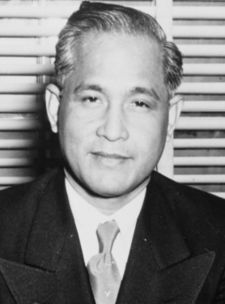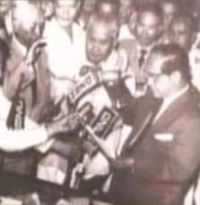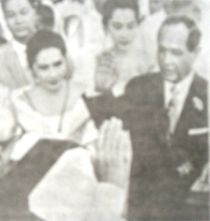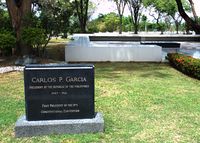Carlos P. Garcia
| Carlos P. García | |
 |
|
|
|
|
| In office March 17, 1957 – December 30, 1961 |
|
| Vice President | None (Mar 17-Dec 30, 1957) Diosdado Macapagal (1957-1961) |
|---|---|
| Preceded by | Ramón Magsaysay |
| Succeeded by | Diosdado Macapagal |
|
1st President of the 1971 Philippine Constitutional Convention
|
|
| In office June 1, 1971 – June 14, 1971 |
|
| President | Ferdinand Marcos |
| Succeeded by | Diosdado Macapagal |
|
|
|
| In office December 30, 1953 – March 18, 1957 |
|
| President | Ramón Magsaysay |
| Preceded by | Fernando López |
| Succeeded by | Diosdado Macapagal |
|
|
|
| Born | November 4, 1896 Talibon, Philippines |
| Died | June 14, 1971 (aged 74) Tagbilaran, Philippines |
| Political party | Nacionalista Party |
| Spouse(s) | Leonila Dimataga |
| Alma mater | Silliman University[1] |
| Profession | Lawyer |
| Religion | Roman Catholicism |
| Signature | |
Carlos Polestico García (November 4, 1896 – June 14, 1971) was a Filipino teacher, poet, orator, lawyer, public official, and guerrilla leader. He became the 8th President of the Philippines known for his "Filipino First" policy, which put the interests of the Filipino people above those of foreigners and of the ruling party.
Contents |
Early life and career
García was born in Talibon, Bohol to Policronio García and Ambrosia Polestico (who were both natives of Bangued, Abra).
García grew up with politics, with his father serving as a municipal mayor for four terms. He acquired his primary education in his native Talibon, then took his secondary education in Cebu Provincial High School. Initially, he pursued his college education at Silliman University in Dumaguete City, Negros Oriental, and later studied at the Philippine Law School (now Philippine College of Criminology) where he earned his law degree in 1923. He was among the top ten in the bar examination.[1]
Rather than practice law right away, he worked as a teacher for two years at Bohol Provincial High School. He became famous for his poetry in Bohol, where he earned the nickname "Prince of Visayan Poets" and the "Bard from Bohol".
He started his political career in 1925, scoring an impressive victory running for congressman representing the third district of Bohol. He was elected for another term, but served only until 1931 when he successfully ran for governor of Bohol. He served as provincial governor for two terms. He became a member of the congress in 1946, and was elected three times to the senate for three consecutive terms from 1941 to 1953.
Vice-Presidency
See Also: Presidency of Ramon Magsaysay
García was the running mate of Ramón Magsaysay in the presidential election of 1953. He was appointed Secretary of Foreign Affairs by President Ramón Magsaysay, for four years concurrently serving as vice-president.
As secretary of foreign affairs, he opened formal reparation negotiations in an effort to end the nine-year technical state of war between Japan and the Philippines, leading to an agreement in April 1954. During the Geneva Conference on Korean unification and other Asian problems, García as chairman of the Philippine delegation attacked communist promises in Asia and defended the U.S. policy in the Far East. In a speech on May 7, 1954, the day of the fall of Dien Bien Phu, García repeated the Philippine stand for nationalism and opposition of communism.
García acted as chairman of the eight-nation Southeast Asian Security Conference held in Manila in September 1954, which led to the development of the Southeast Asia Treaty Organization, known as SEATO.[2]
Presidency
Accession (1957)

1957 Presidential Election
Incumbent President Carlos P. García won his opportunity to get a full term as President of the Philippines after the untimely death of President Ramón Magsaysay in a plane crash in March 1957. His running mate, Senator José Laurel, Jr. lost to Pampanga Representative Diosdado Macapagal. This was the first time in Philippine electoral history where a president was elected by a plurality and not majority, and in which the president and vice president came from different parties.
Full Term (1957-1961)

Domestic Policies
President García exercised the Filipino First Policy, for which he was known. This policy heavily favored Filipino businessmen over foreign investors. He was also responsible for changes in retail trade which greatly affected the Chinese businessmen in the country. He also made a program focused on thriftiness.
García's administration was characterized by its austerity program and its insistence on a comprehensive nationalist policy. On March 3, 1960, he affirmed the need for complete economic freedom and added that the government no longer would tolerate the dominance of foreign interests (especially American) in the national economy. He promised to shake off "the yoke of alien domination in business, trade, commerce and industry." García was also credited with his role in reviving Filipino cultural arts.[3]
Bohlen–Serrano Agreement
During his administration, he acted on the Bohlen–Serrano Agreement which shortened the lease of the US Bases from 99 years to 25 years and made it renewable after every five years.
1961 Presidential Election
At the end of his second term, he ran for re–election in the Election 1961 in November 1961, but was defeated by Diosdado Macapagal, who served as Vice-President under him, but belonged to the opposing Liberal Party - in the Philippines the President and the Vice-President are elected separately.
Post-presidency

After his failed re–election bid, García retired to Tagbilaran to live as a private citizen. On June 1, 1971, García was elected delegate of the 1971 Constitutional Convention. The convention delegates elected him as the President of the Convention. However, just days after his election, on June 14, 1971, García suffered a fatal heart attack. He was succeeded as president of the Convention by his former Vice-President, Diosdado Macapagal.
García is the first president to be buried at the Libingan ng mga Bayani.
References
- ↑ 1.0 1.1 "Carlos P. Garcia". National Historical Institute. Retrieved 2010-06-16.
- ↑ Eufronio Alip, ed., The Philippine Presidents from Aguinaldo to García (1958); Jesús V. Merritt, Our Presidents: Profiles in History (1962); and Pedro A. Gagelonia, Presidents All (1967). See also Hernando J. Abaya, The Untold Philippine Story (1967). Further information can be found in Ester G. Maring and Joel M. Maring, eds., Historical and Cultural Dictionary of the Philippines (1973).
- ↑ Eufronio Alip, ed., The Philippine Presidents from Aguinaldo to García (1958); Jesús V. Merritt, Our Presidents: Profiles in History (1962); and Pedro A. Gagelonia, Presidents All (1967). See also Hernando J. Abaya, The Untold Philippine Story (1967). Further information can be found in Ester G. Maring and Joel M. Maring, eds., Historical and Cultural Dictionary of the Philippines (1973).
- Zaide, Gregorio F. (1984). Philippine History and Government. National Bookstore Printing Press.
| Political offices | ||
|---|---|---|
| Preceded by Fernando Lopez |
Vice President of the Philippines 1953–1957 |
Vacant
Title next held by
Diosdado Macapagal |
| Preceded by Ramon Magsaysay |
President of the Philippines 1957–1961 |
Succeeded by Diosdado Macapagal |
|
|||||
|
|||||